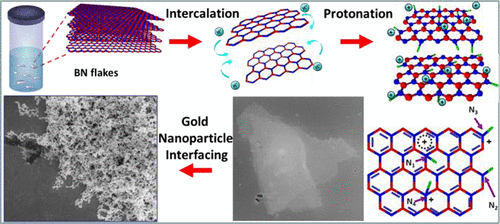Our official English website, www.x-mol.net, welcomes your
feedback! (Note: you will need to create a separate account there.)
Introduction of Protonated Sites on Exfoliated, Large-Area Sheets of Hexagonal Boron Nitride
ACS Nano ( IF 15.8 ) Pub Date : 2018-09-18 00:00:00 , DOI: 10.1021/acsnano.8b03651 Kabeer Jasuja 1 , Kayum Ayinde 2 , Christina L. Wilson 2 , Sanjay K. Behura 3 , Myles A. Ikenbbery 2 , David Moore 4 , Keith Hohn 2 , Vikas Berry 3
ACS Nano ( IF 15.8 ) Pub Date : 2018-09-18 00:00:00 , DOI: 10.1021/acsnano.8b03651 Kabeer Jasuja 1 , Kayum Ayinde 2 , Christina L. Wilson 2 , Sanjay K. Behura 3 , Myles A. Ikenbbery 2 , David Moore 4 , Keith Hohn 2 , Vikas Berry 3
Affiliation

|
Hexagonal boron nitride (h-BN) sheets possess an exclusive set of properties, including wide energy band gap, high optical transparency, high dielectric breakdown strength, high thermal conductivity, UV cathodoluminescence, and pronounced thermochemical stability. However, functionalization of large h-BN layers has remained a challenge due to their chemical resistance and unavailable molecular-binding sites. Here we report on the protonation of h-BN via treatment with chlorosulfonic acid that not only exfoliates “large” h-BNs (up to 10 000 μm2) at high yields (∼23%) but also results in their covalent functionalization by introducing four forms of aminated nitrogen (N) sites within the h-BN lattice: sp2-delocalized and sp3-quaternary protonation on internal N sites (>N+═ and >NH+−) and pyridinic-like protonation on the edge N sites (═NH+– and −NH−). The presence of these groups transforms the chemically passive h-BN sheets to their chemically active form, which as demonstrated here can be used as scaffolds for forming composites with plasmonic gold nanoparticles and organic dye molecules. The dispersion of h-BNs exhibits an optical energy band gap of 5.74 eV and a zeta potential of ζ = +36.25 mV at pH = 6.1 (ζmax = +150 mV), confirming high dispersion stability. We envision that these two-dimensional nanomaterials with an atomically packed honeycomb lattice and high-energy band gap will evolve next-generation applications in controlled-UV emission, atomic-tunneling-barrier devices, ultrathin controlled-permeability membranes, and thermochemically resistive transparent coatings.
中文翻译:

在大面积六角形氮化硼片状剥离片上引入质子化位点
六方氮化硼(h-BN)板具有一组独特的性能,包括宽能带隙,高光学透明性,高介电击穿强度,高导热性,UV阴极发光和明显的热化学稳定性。然而,由于它们的耐化学性和不可用的分子结合位点,大的h-BN层的功能化仍然是一个挑战。在这里,我们的h-BN的质子化报告经由处理用氯磺酸,不仅剥落“大” H-贝叶斯网络(最多10个000微米2)以高收率(〜23%),而且还导致了其共价官能化通过引入h-BN晶格内有四种形式的胺化氮(N)位:sp 2 -delocalized和sp 3内部N位(> N + ═和> NH + -)上的四级质子化和边缘N位(═NH + -和-NH-)上的吡啶基类质子化。这些基团的存在将化学钝化的h-BN片转变为它们的化学活性形式,如此处所示,可以用作形成等离子金纳米颗粒和有机染料分子的复合材料的支架。H-贝叶斯网络的分散表现出5.74伏特的光学能带隙和在pH = 6.1(ζζ= 36.25毫伏的ζ电势最大值= +150 mV),确认具有高分散稳定性。我们设想,具有二维原子填充的蜂窝状晶格和高能带隙的二维纳米材料将发展下一代应用,用于受控紫外线发射,原子隧道势垒装置,超薄受控渗透膜和热化学阻性透明涂层。
更新日期:2018-09-18
中文翻译:

在大面积六角形氮化硼片状剥离片上引入质子化位点
六方氮化硼(h-BN)板具有一组独特的性能,包括宽能带隙,高光学透明性,高介电击穿强度,高导热性,UV阴极发光和明显的热化学稳定性。然而,由于它们的耐化学性和不可用的分子结合位点,大的h-BN层的功能化仍然是一个挑战。在这里,我们的h-BN的质子化报告经由处理用氯磺酸,不仅剥落“大” H-贝叶斯网络(最多10个000微米2)以高收率(〜23%),而且还导致了其共价官能化通过引入h-BN晶格内有四种形式的胺化氮(N)位:sp 2 -delocalized和sp 3内部N位(> N + ═和> NH + -)上的四级质子化和边缘N位(═NH + -和-NH-)上的吡啶基类质子化。这些基团的存在将化学钝化的h-BN片转变为它们的化学活性形式,如此处所示,可以用作形成等离子金纳米颗粒和有机染料分子的复合材料的支架。H-贝叶斯网络的分散表现出5.74伏特的光学能带隙和在pH = 6.1(ζζ= 36.25毫伏的ζ电势最大值= +150 mV),确认具有高分散稳定性。我们设想,具有二维原子填充的蜂窝状晶格和高能带隙的二维纳米材料将发展下一代应用,用于受控紫外线发射,原子隧道势垒装置,超薄受控渗透膜和热化学阻性透明涂层。











































 京公网安备 11010802027423号
京公网安备 11010802027423号